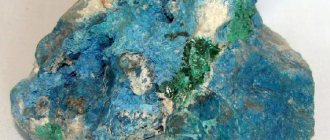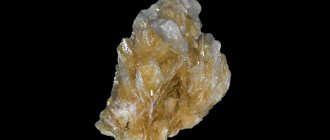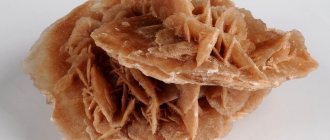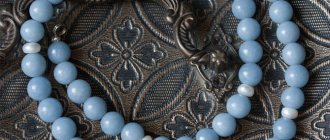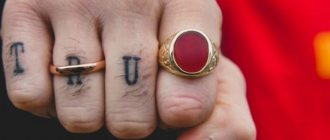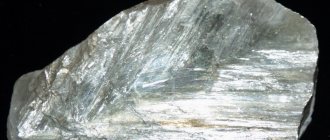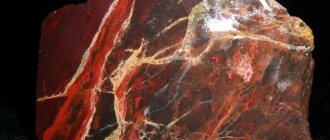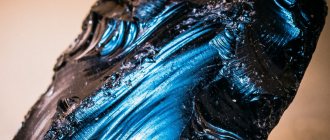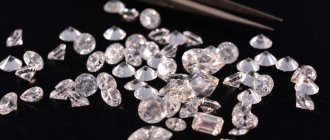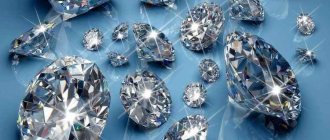There is an ancient legend: if you press the malachite stone to your body, you can become invisible and learn to understand the language of animals.
No other mineral on earth has such magical characteristics.
In addition to its magical and healing properties, the green patterned gem is one of the most beautiful and popular in the world: it is used to make real works of art, unique jewelry, and was used for the interior decoration of palaces.
We’ll take a closer look at other characteristics in this article.
What is this stone?
What it looks like, photo:
Russia was one of the first to start mining malachite on an industrial scale. Not only jewelry and interior decoration of palaces, but also copper were made from it.
There were many names. Malachite was especially often called curly or peacock stone for its patterning and play of green shades.
The Ural mines are the place where malachite was mined in Rus', where it was processed, producing amazingly beautiful mosaics, vases, and boxes.
Bazhov’s work “Malachite Box” is the hallmark of magical malachite. Semi-precious or ornamental stone belongs to copper ores, since it contains the highest percentage of copper.
Malachite Box
Common in areas of oxidation of copper deposits.
The surface of the gem is a non-repeating pattern: waves, shade transitions, stains, “eyes”, dark rings, stripes.
Malachite deposits are often the predecessors of copper ore deposits. Its “neighbor” is considered to be azurite, which, according to observations, subsequently also turns into malachite.
Previously, the mineral was very expensive and was considered precious. There are quite a lot of deposits of it, so the price is relatively low.
Nowadays it is actively used in jewelry and stone cutting, and is presented as a gift at government receptions.
DESCRIPTION AND PROPERTIES OF MALACHITE STONE WITH PHOTO
Malachite is a stone whose properties classify it as a carbonate. It is a valuable ornamental material. The formation of crystals occurs in the form of thin needles that never grow singly. They grow from the center, creating radiant balls - peculiar spherulites. Such spherulites creep on top of each other, forming kidney-shaped and grape-shaped intergrowths. These formations are fed by copper solutions containing varying amounts of copper. That is why each layer has its own shade.
Look at the malachite pictured, the photo shows its shades well: from bluish-green to dark green (almost black) with pronounced patterns on the cut. The patterns are especially visible on cuts and chips after polishing. The pattern is a beautiful pattern of rings and interlacing strips of different thicknesses. Specimens with thin concentric rings are of high value. This variety is called “peacock eye” or “stone”. When processing a mineral, they try to highlight its decorative properties as clearly as possible, especially its banding.
Malachite is found in two types:
Plisovy is a dense green mineral with a wavy-banded structure and a characteristic silky sheen;
Turquoise is a bluish-green variety that is concentrically banded. Particularly popular is a turquoise gem with a subtle pattern, with the so-called peacock eye.
Origin story
Photo of unprocessed malachite:
The first deposits date back more than 6 thousand years and are located in Africa (north and central part).
It is known that stone was originally used to make tools. And only then they began to use it in jewelry.
Malachite also served as a source of copper mining.
Different countries have their own stories about the charming and mysterious malachite:
- The gem was especially revered in Ancient Egypt. It was believed that he was a symbol of the goddess Hathor, who brought fertility to people and was responsible for female attractiveness and happiness in family life. In Rome - the goddess Venus.
- In India, malachite is considered a stone that can completely cleanse the subtle bodies and energy centers (chakras) of a person.
Malachite began to be used as jewelry already during the Middle Ages. Then other methods of copper mining were invented, and large deposits in Europe began to deplete.
Not only decorations, but also the mosaic method of decorating interior decoration (tables, columns, doors) gained popularity.
The Russian mosaic method, reminiscent of lace, opened up new possibilities for using stone. Thin plates, when connected, formed enchanting patterns.
Wall panels, vases and boxes were also created. However, there are very few objects in the world carved from solid pieces of malachite, since large sizes are not typical for the mineral.
But even small fragments have viscosity and softness, which makes malachite one of the most convenient stones for processing.
The style of Russian mosaic became known far beyond Russia, starting in the 1830s. It was then that Demidov, a Russian industrialist involved in stone mining, introduced amazing malachite products to a wide range of people.
Tabletop made using Russian mosaic technique. Ural Geological Museum.
And the exhibition, held in 1850, made the mineral worldwide popular as a jewelry stone, used for interior decoration and the manufacture of luxury items.
In mineralogy, malachite officially received its place in 1747 thanks to a scientist from Sweden.
Over time, samples of malachite of lower quality began to be used to obtain turquoise-colored paint. It was used to paint the roofs of houses, the outer parts of buildings, and was used in painting.
Meaning
There are still disputes between mineralogists from different countries about the origin of the name of the stone.
There are several most famous versions:
- Malachite comes from the Greek. μολόχη - poplar, mallow, by analogy with patterned designs with plant leaves.
- The name was obtained due to the softness of the mineral, derived from the Greek word malakos - soft.
- In ancient times in Rus' and in the Middle Ages, the Latin name “Molochites” was used, which had a synonymous form “Murrin”.
- Until the 18th century among pundits it was customary to call malachite melochiles, melochites, molochites (from the Latin). Mineralogist from Sweden Valery suggested calling it “Malachite”.
- On the territory of Russia for a long time (until the 19th century) the mineral was called “Malakhid” and “Malakid”. And the popular names are curly stone, peacock eye and velvet ore.
WHAT DOES MALACHITE LOOK LIKE
Anyone who has seen what malachite looks like will agree that it is one of the most beautiful stones. All kinds of shades from light bluish-green to rich dark green are present in this stone.
The unique texture gives the gem its unique character.
Depending on the angle of incidence of the light beam, some areas of the mineral appear lighter than others, the so-called pleochroism. According to the classifications of the mineralogist from Germany M. Bauer and academician A.E. Fersman, malachite occupies a leading position among semi-precious stones, along with lapis lazuli, rock crystal, agate and jasper.
Physical properties
The famous green tones are given to the stone by copper, the amount of which can reach at least 57% (Cu). And additional colors are obtained from the admixture of iron. CO2 (carbon dioxide) – 19.9%, H2O (oxygen) – 8.2%,
The mineral is very easy to scratch and break. It is soluble in acids and releases carbon dioxide in this process.
Distinctive characteristics are low hardness and viscosity, which simplify processing.
The original name in science is copper bicarbonate.
Characteristics:
| Chemical formula | Cu2CO3(OH)2 |
| Impurities | Fe (iron) |
| Color, trait | All shades of green, starting from bluish-turquoise and ending with saturated tones, the brightness depends on the density. |
| Shine | Matte, the crystals have a glassy appearance, if aggregates or fine-fiber crystals, then silky, “velvet”. |
| Cleavage | Perfect |
| Mohs hardness | 3,5 – 4 |
| Density | 3.75 - 3.95 g/cm3 |
| Kink | Splintered, shell-like |
| singonia | Monoclinic |
| Transparency | Not transparent |
| Refractive index | 1,656 – 1,909 |
The structure of the crystals is needle-like, prismatic or lamellar. If there is a mechanical impact, the crystals take on a spherical or dendroid shape.
It melts due to high temperature. It is very difficult to find well-formed crystals: they are generally small and rare.
Field
Previously, malachite was mined in huge quantities in Russia (until 1917). Now the reserves are almost exhausted; small amounts of mining remain on Lake Baikal.
Gemstones from the Korovinsko-Reshetnikovskoe deposit and Altai are also supplied.
The most active production and export is carried out in the Congo. The stones from there have a characteristic bright pattern and cylindrical design.
There are several other deposits in the world, but not so large:
- France;
- Germany;
- Kazakhstan;
- England (County Cornwall);
- Australia;
- Italy;
- Namibia;
- Chile.
African malachite
African malachite has bright shades and alternating light and dark stripes of green color, which makes the stone original with a spectacular color scheme.
Varieties
When classifying malachite, the pattern, design and texture are taken into account. Some stones are only suitable for copper mining, but other specimens are quite interesting and can be used for jewelry.
This table will help you understand the groups:
| Name | Description |
Kinds:
|
|
Pseudomorphoses, aggregates, compounds with other minerals:
|
|
Plush
Nodular
Radiant
Pseudomalachite
Atakamite
Chrysocolla
Aurichalcite
Cuprite
Native copper
The mineral composition is similar to malachite. Often they grow together and represent monolithic original specimens.
They are used for the manufacture of decorative items in a single copy, which are especially highly valued.
Malachite + other rocks
After joining, crystals are obtained, which include several gems:
Calcite – malachite
It is a mixture consisting of gypsum, malachite and calcite.
Azurmalachite
One of the most popular combinations, characterized by an interesting greenish-blue tint. Both elements grow together to form one crystal.
Star malachite
Chalcedony is interspersed with round-shaped malachite spots.
Agate – malachite
The latter is expressed by spots of a greenish tone and looks beautiful in the overall structure of jasper.
Eilat stone
A combination of 3 minerals: malachite, chrysocolla and azurite. The stone has a dark, rich green color with bluish inclusions.
Lapis - malachite
This is a duet of quartz and malachite.
Mysoreen
An original gem combining malachite, chrysocolla and calcite.
There is also pressed malachite, which is obtained artificially: small pieces are combined into a single stone using technologies that use high pressure.
Pressed malachite
Color varieties
The color of any variety of malachite is green. The specimens differ from each other in shades and patterns. Based on this, the mineral is divided into the following types:
- Finely patterned. A rare variety of mineral, which was especially valued in the Urals. A cut of a stone represents a pattern in the form of birch leaves. It is interesting that it was this type of mineral that became the inspiration of Pavel Bazhov.
- Velvet (or plush). This species is difficult to process, as it has a fine-grained structure. And the texture of the mineral resembles suede, velor or velvet, which is what gave the stone its name.
- Turquoise (or pseudomalachite). In fact, it is copper phosphate, a stone of a different origin, not related to malachite. However, the texture of the mineral is similar to malachite, endowed with a turquoise tint and increased hardness.
As for patterning and color saturation, samples of the mineral differ from each other depending on the place of extraction. Thus, African stones are brighter in color than Ural stones, and the rings and circles of the pattern are larger and have a regular shape. “Ural green” has a slightly different pattern - the pattern consists of contrasting stripes that separate light and dark shades of green.
Magic properties
Since ancient times, sorcerers and magicians have actively used stone in rituals. Malachite is an energy stone, strong and has great natural strength.
Therefore, it is recommended to take it with you on trips to nature.
There are other meanings:
- It is considered a kind of conductor between the other world and the real one.
- In ancient times, they always took it with them when hunting. Foresters and rangers used it as a talisman against accidents. Malachite helps to understand the language of animals and becomes invisible (according to legend).
- If you wear the mineral for a long time , then the animal nature begins to awaken in a person, and emotions begin to take over the mind.
- Women wearing jewelry with malachite become very attractive to men, but not only positive fans appear, but also not very decent ones.
- If a person has a profession related to creativity , then the stone will help achieve high results, give inspiration, and suggest the right decisions to practitioners.
Malachite helps those who have their own business, as well as public people, to become successful and rich, as well as to receive the support and favor of colleagues and subordinates.
Interesting: if the stone has cracked into small pieces, it is a sign for the owner to be extremely careful and think about his health.
APPLICATION OF MALACHITE
The mineral has useful gemological properties and has not only aesthetic, but also practical significance for humans. The scope of its application is extremely wide and covers all areas of life: from everyday life to health.
Malachite stones, being valuable and, today, already rare, are used for the following purposes:
- For the production of paints.
- For the purposes of decorating premises (manufacturing: panels, columns, tabletops, etc.)
- For making crafts (mosaic work, boxes, etc.).
- For jewelry production.
- For magical purposes (talismans and amulets).
- For medicinal purposes.
Healing and magical properties
The magical properties of the stone include the ability to attract success, luck and make wishes come true.
The meaning of the malachite stone in esotericism:
- Reveals the speech of animals to people;
- Turn a person invisible;
- Eliminates harmful connections;
- Treats fear of heights;
- Helps achieve your goals;
- Protects on long journeys.
The ornamental stone is used in amulets for children: the cut mineral protects against the evil eye and envy.
Malachite and Zodiac
How malachite combines with representatives of the zodiac signs:
| Zodiac sign | Compatibility with malachite |
| Aries | Yes (intelligence improvement) |
| Taurus | Yes (improved mood) |
| Twins | Yes (promotes peace) |
| Cancer | No |
| a lion | Yes (promotes health) |
| Virgo | Yes (serves as a talisman and amulet) |
| Scales | Yes (helps calm nerves) |
| Scorpion | Yes (helps enhance intuition) |
| Sagittarius | Yes (serves as a talisman and amulet) |
| Capricorn | Yes (helps calm nerves) |
| Aquarius | Yes (recuperation) |
| Fish | Yes (helps calm nerves) |
Among those for whom malachite is suitable according to the Horoscope, one can primarily name TAURUS: this zodiac sign, like the constellation TAURUS, is protected by the element of Earth and the planet Venus.
The zodiac sign CANCER is not compatible with malachite. The mineral can cause irritation, aggression and great anxiety in CANCER.
Medicinal properties
Malachite, according to lithotherapists, is able to heal and eliminate symptoms in many cases.
This is a real natural healer. Healing properties:
- Promotes the appearance of thicker hair (you will need to purchase a hairpin with a gem).
- If your joints hurt , then you can apply malachite plates to the sore and inflamed areas.
- To normalize high blood pressure , you need to wear beads or a pendant.
- To prevent disruptions in the nervous system, it is recommended to simply look at malachite crystals (the pattern and pleasant color scheme have an equally calming effect).
- To improve memory , organize and concentrate faster, it is advisable to place a small malachite figurine on your desktop or in your office.
- Earrings with a gem will improve your eyesight.
- For skin diseases, they use water in which malachite has been left for several hours. You can sprinkle problem areas with powder made from malachite.
- People with respiratory tract diseases , including those in the chronic stage, need to wear a pendant on their chest.
Women should wear the stone during pregnancy, and for those diagnosed with cancer, malachite will help reduce metastases.
The brighter the stone, the greater its healing properties. Malachite has a healing effect due to its high copper content, which has a beneficial effect on the human body.
Who is suitable according to their zodiac sign?
Malachite has its “favorites”, and for some representatives of the astrological zodiac system it only enhances the negative qualities in their character.
Therefore, according to the horoscope, the mineral is not recommended for Scorpios , Cancer and Virgo .
It influences others very positively:
- Pisces will be able to understand people better and concentrate on the main thing.
- Libra will become even more attractive to others, gaining charisma and charm.
- Aries will gain calm and diplomacy.
- Aquarians will forget past grievances and become more cheerful.
- Taurus will be able to find the root of all problems and failures in life.
- Capricorns will sleep better and stop worrying a lot.
- Sagittarians will demonstrate parental qualities to the maximum and devote more time to their family.
You should give the stone a rest and periodically remove jewelry, and also carefully observe whether it reinforces the negative. Otherwise, use another mineral.
Malachite belongs to the “earthly” element; its patron is Saturn.
Malachite stone and zodiac signs
The sign you were born under determines not only your destiny, but also your energy. It is best to match the aura to the character of the stone you are wearing.
As for malachite, according to the horoscope it is suitable for Libra , Gemini , Taurus , Leo , Sagittarius , Virgo and Capricorn . The gem will help them smooth out negative character traits and direct them in a creative direction. Those born under these signs will reveal their creative potential with the help of a crystal and will become luckier and happier.
Astrologers do not recommend acquiring a malachite talisman for Pisces and Cancers.
Astrologers recommend the gem for Aries , especially women. They often suffer from their own selfishness, stubbornness, and inability to put themselves in the place of another person. This complicates relationships with others, especially with managers and the opposite sex. Malachite will teach Aries to value others and their interests. This will have a beneficial effect on your career and personal life.
The stone is not recommended for Cancers and Pisces - they can become arrogant, prone to excessive risks and shocking behavior. Such an impact can lead to conflicts with loved ones or with the law, and even danger to life.
For all other zodiac signs, malachite is initially neutral, but can bring both benefit and harm.
To avoid possible negative consequences, it is better to try to achieve harmony with the talisman. Interested in malachite? Then you will like these stones: jade, aventurine, turquoise. Enjoy reading!
Talismans and amulets
In Ancient Egypt, amulets were made for children to improve sleep and calm them down. The stone was believed to ward off evil spirits.
And in the Urals, a green patterned gem is considered a stone of joy and happiness. Products with malachite especially help people with a kind heart and pure intentions.
You can have a mineral even without cutting. It's great for meditation. It is better to purchase a stone in spring or summer, then it will help and support, and give strength.
Acquired in autumn and winter – carries the energy of withering.
Magical and healing properties of Ural malachite
They began to endow the green mineral with magical properties back in the Middle Ages. Small pieces of malachite were hung over a baby's crib, in the belief that they would ward off evil spirits and the baby would sleep peacefully. To protect an adult, malachite was engraved, usually in the form of the sun.
It was believed that malachite was a good helper in love rituals. It was often mentioned in fortune telling and magic books as a means of attracting love and keeping it. Traditional healers used malachite to treat allergies and skin diseases, asthma and migraines.
Decorations
Malachite is rarely combined with gold. Silver, cupronickel or copper are more suitable for the mineral as a cut. Jewelry is suitable for men and women equally.
For the latter, these are earrings, bracelets, necklaces, beads, rings (worn only on the middle finger of the left hand or on the little finger).
The male half can buy checkers, figurines, cufflinks, watches with thin cupronickel plates inside, backgammon, checkers and chess.
Other uses of stone
Malachite products look especially beautiful in any interior, giving it an aristocratic feel: these can be figurines, vases, candlesticks, lamps and boxes, ashtrays.
In ancient times, they learned how to make cladding from thin plates and cover surfaces (tables, columns, etc.) with malachite, but now such work is no longer carried out due to the depletion of deposits.
Price and care
The cost of ornamental stone starts from $5 per gram.
If the work is handmade by a famous master, then the cost of the jewelry can reach 5 thousand rubles. And so earrings, beads and sets start from 500 rubles. and reach 2 thousand rubles.
The stone should not be thrown; it must be looked after very carefully. Rinse periodically with warm water and wipe with a dry cloth, keep away from fire, do not treat with acids or abrasives.
If the stone is necessary for treatment, then to cleanse it it must be placed in the ground overnight, which is periodically replaced with fresh soil.
It is better to store in a dark and dry place. It is important to remember that malachite is a fragile and soft stone.
How to distinguish from a fake?
In the photo: on the left – fake, on the right – natural stone
The mineral is not considered expensive and is rarely counterfeited. But still, scammers can deceive here if you don’t know how to distinguish natural malachite from artificial one.
Rules:
- Glass does not heat up when applied to the skin, but malachite immediately becomes warm.
- The mineral can be easily scratched with a piece of glass or a needle.
- A real mineral does not have ideal lines or symmetry. This is the main difference. Upon closer examination, the surface of a fake will be perfectly smooth, while that of malachite will have chips and cracks.
On the left is a fake, on the right is a real stone. Pay attention to the cut lines (indicated by arrows) - 3 imitation colors against countless shades of natural malachite
You can also find more professional imitations:
- Pressed chips of malachite combined into a stone.
- Artificially grown malachite, which is obtained in laboratories. Only a professional with special equipment can distinguish it from the real thing.
HOW TO WEAR MALACHITE | CARE AND STORAGE
Products made from this mineral are not suitable for everyone: they are bulky and overly noticeable.
When choosing malachite jewelry, be sure to take into account:
- clothes (the green color of the mineral is especially suitable for red, black and all shades of tea rose);
- event (a stone not for daily wear, but for festive occasions);
- physique (massive jewelry is not suitable for people with excessive thinness);
- gender (for men there is a wide range of rings and cufflinks);
- age (the stone is suitable for middle-aged and older people).
Silver and copper alloys are more suitable for setting jewelry, but it is better to avoid gold, although it is also patronized by Venus. However, in combination with a green gem, a gold frame in jewelry is not recommended, especially if the jewelry is used for magical purposes.
You should also be careful when wearing or giving a gem to green-eyed girls: the bright color of the stone can “interrupt” the natural radiance of the eyes.
When wearing contrasting colors (for example, red), be sure to choose a similar brightness of color, otherwise the contrast will look tacky.
How to distinguish natural stone from fake
Unfortunately, reserves of the mineral are becoming smaller every year, so they are increasingly trying to counterfeit it.
We recommend: TOP 15 varieties of QUARTZ STONE
We do not take into account fused or glued malachite chips, which are easily recognized by their identical, patternless surface. It is usually used for cladding and decorative purposes, as well as for the production of products in the economy segment.
We are talking about a complete fake of malachite using glass and plastic.
How to determine whether a stone is natural or artificial | 5 ways
- Apply a drop of alcohol to the reverse side of the jewelry: if the color of the drop changes to blue, and the product itself changes to white, this is natural malachite. If the color has not changed, it is a fake.
- A genuine mineral is always cool, while an artificial one is warm.
- If glass is passed off as a mineral, bubbles are easy to see under a magnifying glass.
- Malachite is easily distinguishable from a fake by its weight: plastic weighs much less.
- If you bring the flame of a match closer to malachite for a couple of seconds, it will immediately become covered with soot. This layer will be easy to clean off.
Important! It is important not to overdo it with the last method of checking: if you expose it to fire for a long time, the stone will turn into charred powder.
How much does malachite cost?
The price of a processed stone directly depends on its type:
- The turquoise variety has a noticeable blue tint and beautiful contrasting stains. Most often used in jewelry production;
- the plush variety has a matte sheen and a texture similar to tree branches. Typically used in making crafts.
You should know! Malachite products (beads, rings, gem necklaces) are now valued at the level of semi-precious. In Russia, when grading malachite, it is divided into three grades, depending on the color characteristics and quality.
What stones does it go with?
The combination of malachite and diamond is beauty, and that’s all
Malachite is “friends” with minerals of the “fire” element: Ruby, pyrope and Diamond.
But other minerals can also become “neighbors”:
- jasper;
- jade;
- chalcedony;
- jet;
- aquamarine;
- emerald;
- moonstone and many others.
Neutral proximity to Amethyst, Chrysoprase, Beryl and Rock Crystal.
Compatibility with other stones
Malachite is undemanding to its neighbors; there are no stones that are completely incompatible with it, with the exception of Fire minerals - ruby, diamond, pyrope.
Beads with malachite
Jewelry with malachite is best combined with the following stones:
- turquoise;
- jasper;
- jade;
- jet;
- chalcedony;
- Hawkeye;
- Bulls-eye.
A successful company may be:
- emerald;
- sapphire;
- aquamarine;
- moonstone;
- disgrace;
- aventurine;
- labrador;
- tourmaline.
Neighborhood with transparent-smoky gems of Air is neutral, does no harm or benefit. These include amethyst, uvarovite, chrysoprase, rock crystal, and golden beryl.
Interesting Facts
- In ancient times, fashionistas used crushed malachite as eye shadow. And for rituals, shamans covered the body with malachite powder.
- If you dream that you are purchasing a malachite box, in reality you will have to meet an unpleasant person.
- Bad dreams with this stone (crashed, broken product) foreshadow illness and failure. Jewelry promises good luck and success.
- A huge malachite weighing 500 kg is located at the Mining Institute.
- You can admire the Malachite Room in the Winter Palace (created according to the design of A.P. Bryullov in 1838 - 39), as well as the columns in St. Isaac's Cathedral (St. Petersburg).
DEPOSITS OF MALACHITE IN THE URAL
Malachite is a valuable industrial ore. But its significance is very limited, since the malachite accumulation is concentrated in the upper, rapidly mined layer of the copper deposit. Sintered malachite with a beautiful pattern is a valuable ornamental stone, widely used in decorative and artistic products.
Today the mineral is supplied from Zaire, Africa, Kazakhstan, and Western Europe. The gem is less common in the form of a large mass. In Russia, the lead in mining is occupied by the Mednorudyansky mine, located near Nizhny Tagil, in second place is the Gumeshevsky mine, where a large malachite block was mined, the weight of which was 1.5 tons.
The block is in the Mining Institute. There are other Ural deposits. Malachite is also found in Kazakhstan and Altai. If previously the main mining of malachite was in the Urals, today it has ceased in this area, since these deposits have been depleted. And once upon a time these were very rich malachite accumulations.
By the way, Ural malachite was discovered back in 1635, and already in the 19th century. it was mined up to 80 tons per year. These were heavy blocks of high-quality natural mineral. The weight of the largest block was 250 tons, it was found in 1835, and in 1913 a block weighing more than 100 tons was discovered.
Dense malachite in solid masses was used for malachite jewelry (pendants, necklaces, earrings, rings, cufflinks), and individual grains of the mineral distributed in the rock (earthy malachite) and small accumulations of pure gem were used to make high-quality green paint, the so-called “malachite green.” " “Malachite green” should not be confused with “malachite green,” which is a simple organic dye and has something in common with the mineral, except perhaps its color.
In Yekaterinburg before the revolution one could see the bluish-green roofs of many mansions. They were painted with malachite, which attracted not only connoisseurs of all things beautiful, but also copper smelters. Copper was extracted exclusively from that stone, which was of no value to artists and jewelers. Whole pieces were used only for making jewelry.
In smaller quantities, but today malachite is also mined; mining is carried out in Western Europe: in Chessy, Retzbania, Cornwall, and the Harz. Today's main deposits of malachite of jewelry and finishing quality are located in the Democratic Republic of the Congo. African stone is characterized by regular concentric rings of small size with a more contrasting change of dark and light layers. Unlike this mineral, Ural gems have irregularly shaped rings.
